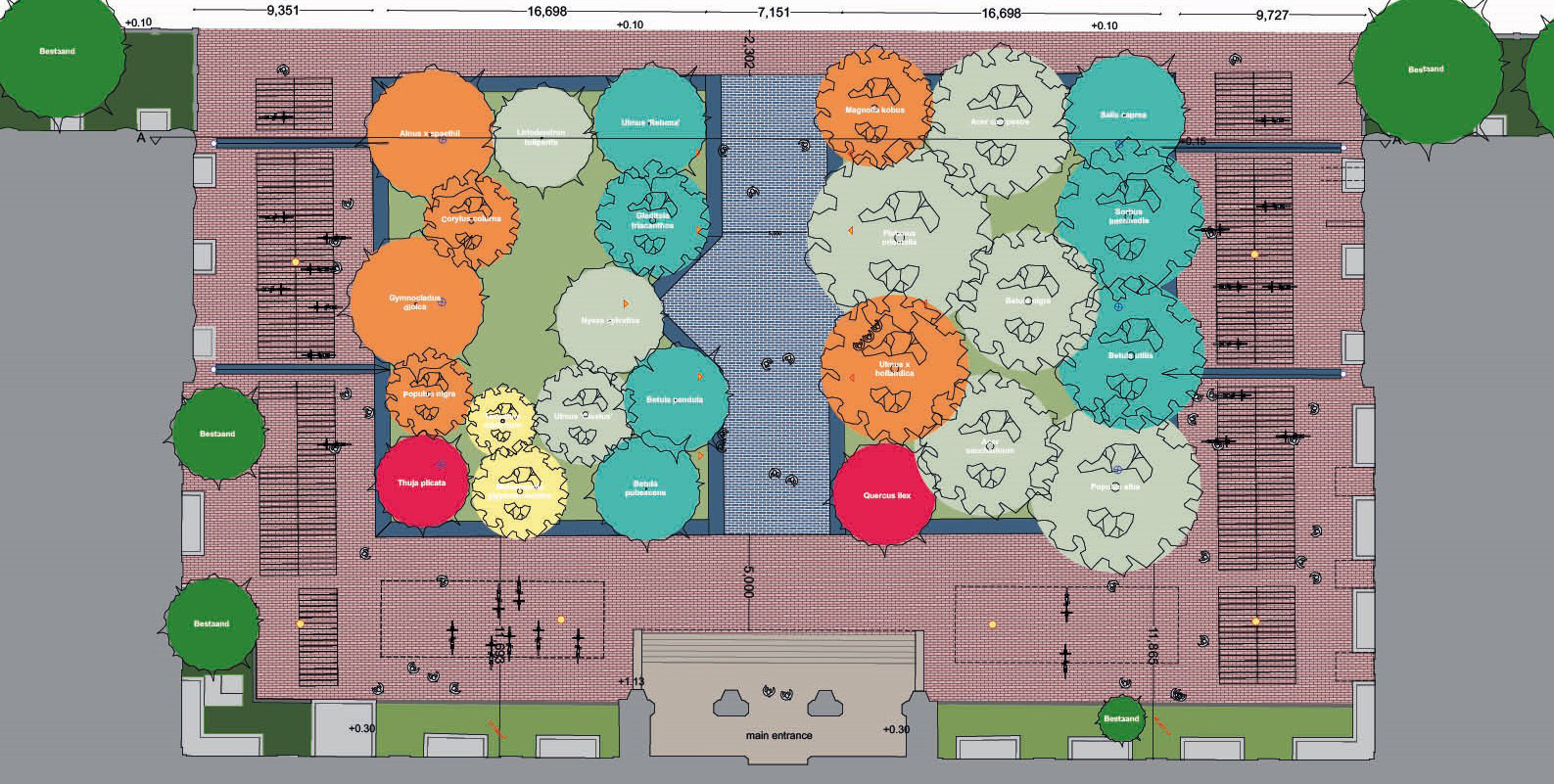From bare bricks to tree-wadi: Bouwkunde renovates its courtyard
In 2024, the courtyard of the Faculty of Architecture and the Built Environment will be transformed into an Urban Climate Grove, in the form of a tree-rich 'wadi' (Arabic for riverbed). This wadi will not only become a nicer place for students and staff, but also facilitate a whole range of new research projects. Dr Nico Tillie: "We will study all levels, from the ground to the sky and from emissions to biodiversity." And according to Dr René van der Velde, "we are going beyond the state-of-the-art... we are inventing a new type of forest."
For years, the courtyard has hosted research into the cooling effect of potted trees. Now these same trees will actually be planted thanks to a team of committed staff members. The core of this team consists of Rosa de Wolf, Nico Tillie (both Urban Ecology), and René van der Velde (Urban Forestry), with support from René Hoonhout (CREFM) who has been working for a greener campus for 33 years. The resulting wadi will have many functions: cooling the square, increasing biodiversity, draining excess water... all kinds of new ideas will be applied, and research will be done at every step.
Innovative construction: clinkers, not compost
The innovations start at the dismantling of the current courtyard. The bricks will be sold and reused ("They are actually quite expensive!" according to Nico), and the bricks for the central walkway will also be second-hand. Foundation for this walkway will consist of old crushed concrete clinkers from elsewhere on campus. Using crushed clinkers instead of sand will make it easier for the trees' roots to spread underneath the paving. And all these recycled materials will make the project completely circular.
With these kind of projects, the soil is usually enriched with compost. However, production of compost often involves excavating peat bogs in, for example, Estonia. This practice is unsustainable. Therefore, the wadi will experiment with minimal use of compost, an initiative that has the interest and attention of the municipal government of The Hague.
Thanks to previous research on the courtyard’s heat stress, researchers know that the trees with the strongest cooling effect (indicated as blue) should be planted in the centre and on the far right.
Research in the wadi: biodiversity and water
The biodiversity aspect of the wadi will entail birds and bats, soil life, insects, and plant development. All these types of biodiversity are encouraged and researched. For example, sections of the wadi will be planted with a wide variety of vegetation species to ensure the availability of flowers throughout spring and summer. Nico: "Besides encouraging insect biodiversity, it also looks beautiful!" Other parts of the soil are intentionally left bare to see what species of plant emerge.
A wadi is a dry riverbed that can suddenly fill up with water. To simulate this natural system, four of the ten surrounding storm drains will be redirected towards the courtyard. In this way, the wadi will help to manage heavy rainfall without overloading the sewers. Rene van der Velde: "we will go from a collection of trees to a tiny forest… how water-resistant will it be?" The trees and other vegetation are placed at different levels depending on their water requirements: the lower the plant, the more rainwater it receives.
The ground vegetation is selected based on flowering period and water resistance.
Finishing touches: special benches and atmospheric lighting
Faculty students once built benches from recycled concrete, in collaboration with researchers. Through clever use of internal metal plates, the benches generate electricity when they heat up and cool down. Now you will be able to use these benches to charge your phone! Nico: "In the future, we want to put up many more innovative benches. To everyone interested: show us your proposal!"
The bicycle parking area around the wadi will be permanently illuminated, but the lights for the central walkway will be low to the ground and as dull as possible. Rosa: "Hopefully these lights will work on motion sensors so that we minimise disruption to life in the wadi." And finally, it should be mentioned that one tree, a willow, will be newly purchased. This willow will be planted in honour of the late professor Tillmann Klein, who devoted his entire career to circularity and sustainability.
More information
- Dr. Ir. Nico Tillie en Ir. Rosa de Wolf are part of the research group Urban Ecology within the department of Urbanism, faculty Architecture and the Built Environment. Dr. Ir. René van der Velde is also part of that department with his own research group, Urban Forestry. These three will take the lead in the diverse research projects in and around the wadi.
- Design firm HOSPER provided the preliminary design for the wadi, and A+BE Dean Dick van Gameren helped with the variant selection. The final design was developed by Nico, René, and Rosa.


